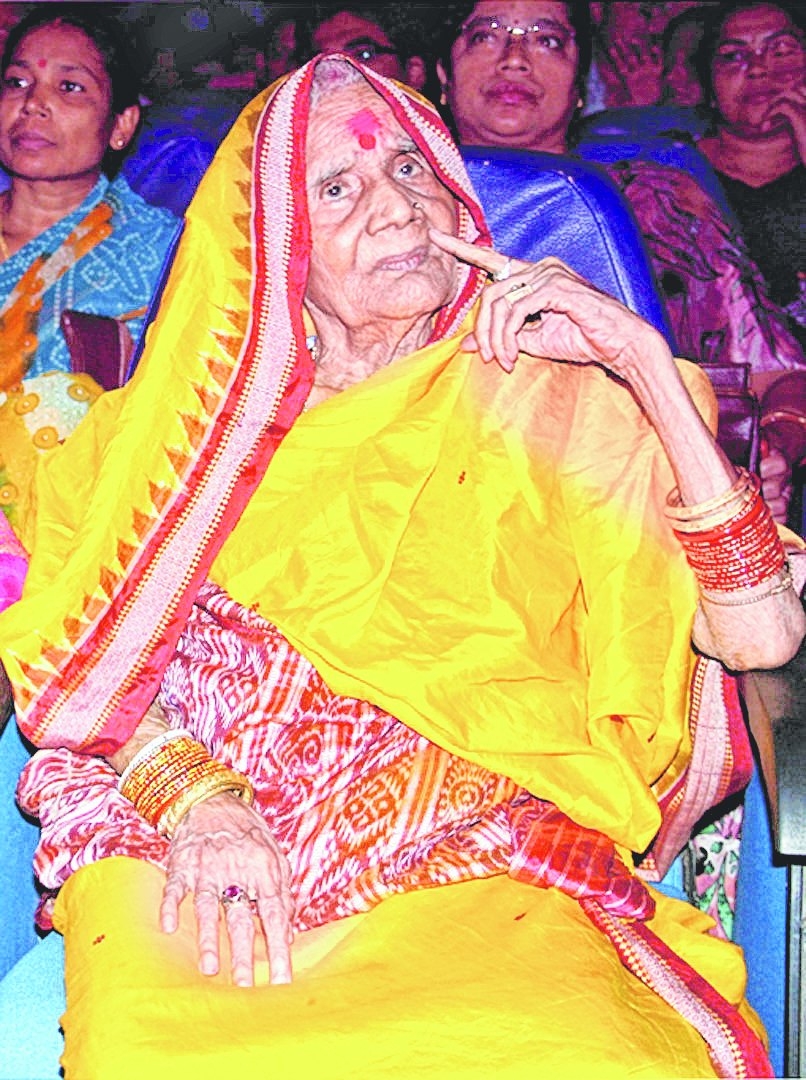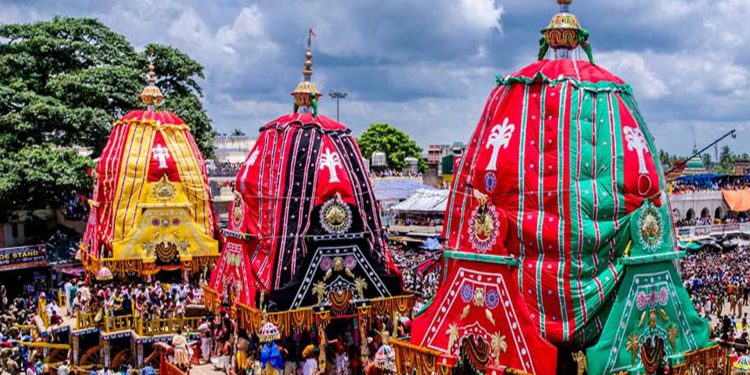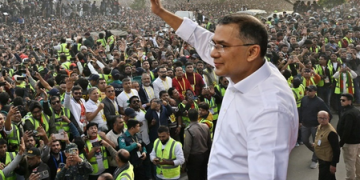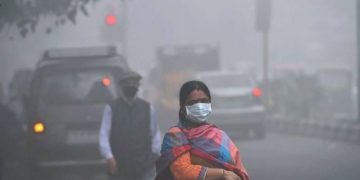Intro: As a result of external invasion, by the Moghul lieutenants in particular, many Gajapati kings in the past could not continue all the rituals initiated by their predecessors. This apart, servitor families having no sons as their successors, failed to render a few services
This year’s world famous annual Rath Yatra of Lord Jagannath came to an end last Saturday with Niladri Bije, one of the most interesting ceremonies associated with the festival. Sunday POST, over the years, has been carrying articles on some lesser known facts about the Lord and his abode Srimandir. Last week’s cover story was about the services rendered by Mudirastas, a unique caterogory of servitors who are minors and perform their duties as the representatives of Puri Gajapati.
It is needless to mention that Gajapati is the foremost servitor of Lord Jagannath and his siblings. However, several other qualified servitors have also been appointed to perform necessary rituals in the temple. They have been traditionally rendering their services since the times of king Anangabhima Dev III. The 13th Century ruler had introduced 120-category of services and also engaged servitors for each category. Some more services were added with the passage of time as per the requirement of the temple and the practice continued for several hundred years. Gradually, as a result of external invasion, by the Moghul rulers in particular, on the Jagannath temple, the subsequent Gajapati kings could not continue all the rituals. Besides, the servitor families having no sons as successors to carry out the tradition stopped performing the rituals. Since there is no system of recruiting new people from outside the sevayat community, some services are no more in operation.
Sunday POST takes a look at some of the important services that have been discontinued over the decades.
Paika Seva
According to Srimandir’s Record of Rights, names of 36 servitors were registered to perform the service in 1954. This service required the servitors to remain present in the temple round the clock on turn basis. On being directed by Dalai and Dalabehera servitors, Paika servitors would go to different places to pick the specific servitors to the temple when the latter had to perform rituals. Besides, they would invite Puja Panda servitors to offer Prasad outside Nrusingha and Lakhmi temples after Madhayna Dhupa (Lunch ) ritual. As many as six Paika servitors used to remain present all the time on the temple premises. Paika Seva had become defunct about 45 years ago.
Parichha Seva
Rajagurus or the royal priests of Gajapati Maharaja were entitled to perform Pariccha seva. This service was associated with the administration of the temple. They were assigned to ensure the smooth conduct of rituals being performed by the other servitors. However, the service is no more part of temple rituals.
Geeta Govinda Seva
Recitation of devotional songs from epic Geeta Govinda, that concentrates Radha-Krishna love, before the deities is known as Geeta Govinda Seva. A Brahmin servitor was assigned to render devotional songs from Geeta Govinda, written by Sri Jayadev Goswami in 12th century AD during the Chandan Lagi procession. However, this ritual was discontinued in 1954. When Brahmin servitors stopped offering the service, one Narayan Acharya from Baseli Sahi was asked by Jagannath Ballav Mutt and Raghav Das Mutt to do the seva for some time. Later, the service was discontinued.
Suara Nijoga Nayak
Suara Nijoga Nayak used to manage all the affairs of Suaras and kitchen. Earlier, servitors coming under Suara Nijoga Nayak category used to supervise employment of Katha Bhoga Suara and look after Daru Ghara. However, all these works managed by Suara Nijoga Nayak are being done by a committee under the guidance of Suara Mahasuara Nijoga after a court verdict in 1870.
Paniki Pata seva
The Panikipata seva has become extinct. It was learnt that a person from Chasa caste was employed to do the Paniki Pata seva. He used to cut fish and vegetables during Sola Puja at Bimala temple. By the time of preparation of Record of Rights, the service had discontinued.
Bhitara Gayani Devadasi
Under Chhatisa Nijoga, Devadasi seva was the only service where women had a big role to play. As many as nine Bhitara Gayani used to offer this service between 1950 and 1955. While the first set of Devadasis was known as Bhitara Gayani, another set of Devadasis was called Bahara Gayani who had rituals to perform outside the inner sanctum of the temple . Bahara Gayani Devadasis were also known as singers of sanctum sanctorum. When Bhitara Gayani Devadasis would dance during Badasinghara (bedtime ritual), Bahara Gayani Devadasis used to sing devotional songs to appease the Lord in other functions. Apart from daily rituals, Devadasis had a special role during the Rath Yatra, Nabakalebara (symbolic recreation of wooden forms of the deities), Chandan Yatra, Phagu Khela and Nanda Utsav. Bhitara Gayani Devadasis used to dance during from Sakala Dhupa ritual at Jaga Mohana. Apart from reciting Geeta Govinda before Ratra Pahuda (the last ritual of the day), they would offer this service during Bala Dhupa (morning offering) ritual in the holy month of Kartik. In the month of Baisakha, they would also perform during Aalata lagi ritual for 42 days prior to Chandan Yatra. Devadasis remained unmarried for whole life and consider Lord Jagannath as their husband. While the Record of Rights (RoR) of the temple indicates that there were about 25 Devadasis about 100 years ago, Orissa Gazette of 1956 lists nine Devadasis and 11 musicians in the Jagannath temple. By 1980, only four Devadasis – Harapriya, Kokilaprava, Parshmani and Sashimani- were left. It was learnt that the Devadasi tradition had been disappeared by the time the state government took charge of temple administration in 1960. However, other rituals associated with the Devadasi tradition were being practiced. Devdasi traditions were maintained till the death of Kokilaprava. After her death, the service was discontinued. Besides, it is learnt that Kokilaprava had not adopted daughter to continue the service.

Kumbhara Bisoi Seva
Kumbhara Bisoi servitors were assigned to supply clay pots and other pottery items for the daily requirement of the temple. Potters at Kumbharapada were assigned to provide the service. In 1906 King Mukunda Dev handed over the charge of making earthen items to Kumbhara Bisoi. As Kumbhara Bisoi servitors failed to provide clay pots to temple on time, it was decided in Temple Managing Committee meeting held in November 29, 1987 to stop the service.
Banua seva
Banua servitors used to supply the fire-works to the temple during festive occasion like Chandan Yatra and temple administration carried the expenses. Beside Banua servitors’ job was to fetch water from well for temple rituals. They would provide rope to fetch water. In Record of Rights, there was the mention of one Ananta Jena as Banua sevak. As the service was not hereditary, none came forward to continue the legacy resulting in withdrawal of the service
Some important servitors who still render their services to Srimandir right through the year:
- Gajapati Maharaja
- Pattajoshi Mohapatra
- Bhitarchha Mohapatra
- Talichha
- Mudirasta
- Deula Purohit
- Puja Panda
- Badapanda
- Pushpalaka
- Khuntia
- Bhandara Mekapa
- Palia Mekapa
- Akhanda Mekapa
- Changada Mekapa
- Khataseja Mekapa
- Pratihari
- Daita
- Pati Mahapatra.
- Patribadu
- Garabadu
- Suarabadu
- Khurinayak
- Mukhapauhala
- Ghatuari
- Gochhikara
- Muduli
- Alatibalita Sevaka
- Puranapanda
- Duttamahapatra
- Lugadhua and Pani Kunda Sevak
- Ballava Jojania
- Bimanabadu
- Anasara Sudasuara
- Hadapanayak
- Bidia Jogania
- Khatuli Sevak
- Astana Pratihari
- Kothabhog Jogania
- Pradhani
- Paila
- Lenka
- Mahasuara
- Jagia Mahasuara
- Amalu Suara
- Pantibadu
- Amalutola, Purakharadi
- Tolabadu
- Rosha Paika
- Baharadeuli Suara
- Baharadeuli Jogania
- Handi Jogania
- Birimunda Samartha
- Kothabhoga Pania
- Panikipata
- Biribuha
- Daudibala
- Churana
- Sabat Nijog
- Pania pata
- Mandani
- Chakaapasara
- Mulia Suansia
- Binakara
- Darpania
- Kothasuansia
- Mahabhoi
- Dayanamali
- Madei
- Badu Mohapatra
- Tatua
- Patara bandha
- Chhatara nijog
- Kahalia
- Sankhua
- Parbajatra Jogania
- Chitrakara
- Rupakara
- Bania
- Tamara Bisoyi
- Karotia
- Bentabindha Paika
- Patara Bisoyi
- Kala Bethia
- Daraji
- Rathabhoi
- Malachula
- Ojha Maharana
- Ghanta Seva
- Gantua
- Ratha Dahuka
- Badhei
- Baidya
- Amunia Chhatara
- Chhamu dihudi
- Chapa Behera
- Chapa dalai
- Tadhau Karana
- Deula Karna
- Kotha Karana
- Chaula Bachha Karan Rashmi Rekha Das, OP






































